Client Industries
Metal Plating
Mining and Ore
Processing
Top of page

Coal-fired Power
Generation
Top of page

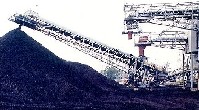
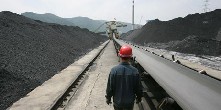
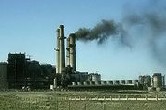

 |
|
 Coal-burning power generation stations consume huge amounts of coal - easily
25 tons (!) every minute - that is a whole train every day. The
massive and slowly moving coal heaps are constantly sprayed
with water - creating perfect acidic conditions for trace amounts of
metals to leach out. With the huge amount of coal throughput,
tons of toxic heavy metals per year end up in the collected drain
water that has to be treated.
Coal-burning power generation stations consume huge amounts of coal - easily
25 tons (!) every minute - that is a whole train every day. The
massive and slowly moving coal heaps are constantly sprayed
with water - creating perfect acidic conditions for trace amounts of
metals to leach out. With the huge amount of coal throughput,
tons of toxic heavy metals per year end up in the collected drain
water that has to be treated.
 Apart from this large contamination source, there are many other
points within a power-plant where metals originate - other major sources are
the boiler 'blow-down' and the flue-gas scrub water.
Apart from this large contamination source, there are many other
points within a power-plant where metals originate - other major sources are
the boiler 'blow-down' and the flue-gas scrub water.
All in all, the power-generating plant is one huge source of toxic
heavy metal release principally due to its enormous size of operation. |
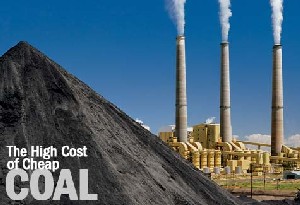 |
 50% of
electricity in the USA originates from coal-burning plants.
The USA coal consumption is the 3rd highest in the world. 50% of
electricity in the USA originates from coal-burning plants.
The USA coal consumption is the 3rd highest in the world.
 China
leads the world in consumption of coal (1,531 millions of tons per
year), followed by Europe (1,117 mty). China
leads the world in consumption of coal (1,531 millions of tons per
year), followed by Europe (1,117 mty).
 By the year 2025, China's coal consumption will double. Worldwide, it will
rise by 56%, remaining constant in the USA.
By the year 2025, China's coal consumption will double. Worldwide, it will
rise by 56%, remaining constant in the USA.
 Direct
water pollution by toxic metals emanating from coal-burning
power-generating plant operations has been a rather "quiet" issue when
compared to the air pollution impacts. These utility operations
represent important Clients for metal removal operations. Direct
water pollution by toxic metals emanating from coal-burning
power-generating plant operations has been a rather "quiet" issue when
compared to the air pollution impacts. These utility operations
represent important Clients for metal removal operations. |
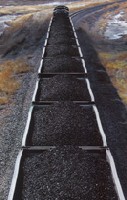  Power
plant air pollution is a conspicuous aspect of its operation. While sulphur
emissions are extremely important, traces of
Mercury escape in power plant exhaust. Falling hundreds of
km away in rain and snow, toxic mercury builds up in the environment
and accumulates particularly in fish. Negative health impacts are well
known. Power
plant air pollution is a conspicuous aspect of its operation. While sulphur
emissions are extremely important, traces of
Mercury escape in power plant exhaust. Falling hundreds of
km away in rain and snow, toxic mercury builds up in the environment
and accumulates particularly in fish. Negative health impacts are well
known. |
  Conventional Methods for Removing Heavy Metals
Top of page
Conventional Methods for Removing Heavy Metals
Top of page

The conventional methods used
so far are usually not adequate any more and the more efficient
alternatives tend to be less feasible because of their relatively high
costs both operating as well as capital.
|
 PRECIPITATION
PRECIPITATION
Conventional precipitation methods of
removing heavy metals rely on formation of insoluble precipitates
using chemical reagents.
The sludges formed must be
separated by settling or filtration.
There are serious
drawbacks:
● The time for precipitation
is long.
● Insoluble metal hydroxides or sulfides
may be difficult to remove.
● Resulting sludges have to be concentrated prior to
their disposal.
● Sludge disposal
represents an enormous problem :
● Toxic metal sludges are invariably classified as
‘hazardous substances’ .
● Recovery of metals
from sludges is usually not feasible.
Major
problem: Precipitation/separation approach has
difficulties in meeting progressively more stringent wastewater
criteria. It generates difficult-to-handle toxic sludges. |
 ION EXCHANGE ION EXCHANGE
A contemporary high-performance process
using synthetic resins usually packed into a flow-through
column. The resin binds metals from solution until it is
saturated.
Then it the column must be taken out of
operation and the desorption-washing procedure follows directly in
the column. As the resin gets regenerated for another use it
releases the metal in the concentrated form in the wash
solution.
Deployment of expensive ion exchange resins for
large volumes of contaminated wastewater has been economically rather
unsustainable and, as a result, application of this process for
wastewater treatment is more often considered not feasible.
Biosorbents are natural
and cheap ion exchangers which operate on exactly the same
principle, using the same standard process equipment: columns,
pumps, valves and pipes. Biosorption is likely to open the
'hidden' wastewater treatment markets considered feasibly
inaccessible. |
 REVERSE OSMOSIS REVERSE OSMOSIS
The process uses
membrane stacks and high pressure. The metal gets concentrated
on one side of the membrane, while purified water ends up on the
other. Membranes are very expensive and easily foul up.
Elevated pressure is also an operating drawback.
This
high-performance system is an expensive alternative treatment
method not feasible for wastewater treatment in most
cases.
 ELECTRO-WINNING METAL RECOVERY: ELECTRO-WINNING METAL RECOVERY:
Metal recovery is possible only from concentrated enough
solutions.
From preconcentrated solutions metals are
recovered by "electro-winning" processes.
Metals are
plated from the solution by electric current applied through
special electrodes accumulating purified metals.
Electro-winning is a standard
conventional technology used 'for profit' by specialized
operators who re-sell the recovered metals.
They collect
suitably pre-concentrated metal solutions for this type of
re-processing coupled with the metal resale.
|
|
 ENVIRONMENTAL vs RECOVERY
CONCERNS: ENVIRONMENTAL vs RECOVERY
CONCERNS:
Metal-laden waste
solutions usually contain metal(s) at concentrations too low for
recovery that is thus not feasible without an effective
pre-concentration step. The wastewater toxic metal content,
however, is high enough to pose a serious environmental
hazard. Biosorption treatment results in low volumes of
high-concentration wash solutions suitable for subsequent metal
recovery.
|
Top of page
 |